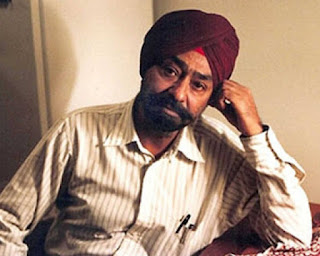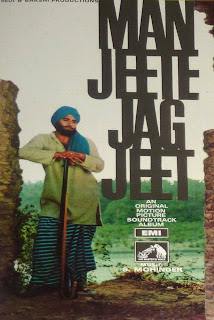S. Mohinder was a versatile composer, who made good use of traditional folk music in his compositions. His original style was Punjabi centric, but Benares groomed him into the classical traditions of Uttar Pradesh and Bombay gave him an all Indian grooming in music. In mid 1950s, his soulful and haunting melody “Guzra Hua Zamana Aata Nahin Dobara…” (Shirin Farhad) virtually reigned the Radio airwaves of Indian Continent. Destiny took him from the depths of obscurity to the centre of Bollywood where his unique compositions cemented his storied legacy. He was abundantly talented and way ahead of his time. His music is full of spirituality and he brought Gurbani to the world forum through Nanak Nam Jahaz Hai (1969). The way Beatles is remembered in the western music, S. Mohinder enjoys the same stature in Punjabi Cinema.
Bakshi Mohinder Singh Sarna (S. Mohinder) was born on February 24, 1925, in Sillanwala, Tehsil Pakpatan (District Montgomery) of undivided Punjab. The title ‘Bakshi’ was awarded to his ancestors by Maharaja Ranjit Singh. His great grandfather Baaz Singh Bakshi was the Governor of Frontier. His father Bakshi Sujan Singh was a police officer, who used to play “Wanjhali” a Punjabi folk musical instrument. The young Mohinder inherited his love for music from his father. He learnt classical music under the tutelage of accomplished Sikh religious vocalist Sant Sujan Singh. He was also groomed by Hazoori musician Bhai Samund Singh Ragi. He did his matric from Khalsa High School, Nankana Sahib in 1942 and graduated from Guru Nanak Khalsa College, Lyallpur. He learnt the intercacies of classical ragas from Ramdas Misra of Benaras. He had the privilege of being a disciple of Bade Ghulam Ali Khan Sahib.
His next film was ‘Jeewan Sathi’(1949) and songs
like “O Dear, My Dear”
and “Mohabbat Rog Ban Kar”
became popular. His musical
prowess attracted the attention of Seth Chandulal Shah, who contracted him for
scoring music of ‘Neeli’ (1950) starring Suriya and Dev Anand. Besides ‘Phool Khile
Hain Gulshan Mein’, its nine other songs became hits. He did big banner movie ‘Shadi
Ki Raat’ (1950) by proxy after the original composer Pandit Govind Ram left the
film midway. His compositions ‘Poochh Rahe Ve Yaar Ki Bibi’ and ‘Hum Dil Ki Kahani’
became very popular. The success soon catapulted
him to regular engagement with Filmistan.
He completed the music of
Filmistan's Shrimati Ji (1952).
There is an interesting story how S.Mohinder missed stardom. He had committed to Anarkali (1953) and showed a couple of tunes to the producer, who rejected them. So he used those tunes for Ranjit Movietone’s Paapi (1953) starring Raj Kapoor and Nargis. Now ‘Anarkali’ producer backtracked and wanted the same tunes. Mohinder was in a dilemma, he went for Paapi. Although this film had buoyant songs like “Meri Zindagi Hai Tu”; “Le Le Gori” and “Tera Kaam Hai Jalna Parwane” but the film flopped.
Next he truly came into his own with “Zanjeer Ne Karwat Li”
(Bahadur-1953) in an awesome sarangi tabla tango. He composed music of ‘Naata’ (1955) produced by Madhubala's
father and Lata’s melodies became instant hits. Next year, he spun magic with
lilting tunes of magnum opus ‘Shirin
Farhad’ (1956). All the nine songs were great hits and ‘Guzara Hua Zamana’ became evergreen iconic
number. The name
and fame he got with “Shirin Farhad” was consummate. He did another film with Madhubala
‘Mahlon Ke Khwaab’ (1960). But he could never re-create the magic of Shirin
Farhad.
Over the next few years he seemed to be swamped with a bunch of lackluster stunt movies like Karvan, Sultan-e-Alam, Pataal Pari, Naya Paisa, Sun To Le Haseena and Bhagwaan Aur Shaitaan. He composed some lovely songs in Khoobsoorat Dhokha (1959) and Mehlon Ke Khwaab (1960). In the same year came Chandulal Shah’s “Zameen Ke Taare” a seemingly cute story which flopped badly despite several cheerful kiddie numbers. In 1961 came Jai Bhawani whose music became quite popular. There were a few more movies in the early sixties like Banke Sanwariya, Zarak Khan, Reporter Raju, Captain Sheroo, Professor X, Sunehre Kadam etc. The only other significant success was the music of ‘Picnic’ (1966). His last Hindi film was Sandli (1985) by Dr. Surjit Singh, who had penned songs in his first movie. He scored music in 34 Hindi films.
By the early 1960s, he felt that melody in Hindi cinema was slowly yielding to noisy heavy metal music. So he decided to go back to his roots and switched to composing music for Punjabi movies. He produced Punjabi movie Pardesi Dhola (1962) under the banner Peony Arts Production and composed eight superhit songs “Vekheya Pishore Vai..”, “Chunni Apni Nu Rang Kita..”, Keeta Si Vachan..” etc. Next he produced Chambe Di Kali (1965) in collaboration with Jasbir Singh Sethi and its music also became popular.
All that classical musical training from Sikh religious
vocalists came handy when he scored the music for the cult movie ‘Nanak Nam Jahaj Hai’ (1969), set to the Sikh tenets. Its music carried best
of kirtan, shabads which were totally raaga based. The story required some
scenes to be picturized in the Golden Temple. He thought that the music for
those scenes being very sensitive must be performed by the finest exponent of
Sikh religious classical music. So he persuaded his mentor Bhai Samund Singh Ragi
to render two Shabads “Kal Taaran Guru Nanak Aaya” and “Miti Dhundh Jag Chanan
Hoya”. S. Mohinder believed that what Bade Ghulam Ali Khan’s singing was to
“Mughal-e-Azam”, the Shabads sung by Bhai Samund Singh are to NNJH. He got Asha
Bhosle to render Shabads like ‘Mere Sahib’ and ‘Re Man Aiso Kar Sanyasa’ while Manna
Dey came fervently with ‘Hum Maile Tum Ujjal’ and a heart tugging ‘Mittar Pyare
Nu’ by Mohammed Rafi. His
music in NNJH touched new heights and won him the prestigious National Film Award for Best
Music Direction in 1969.
His association with his cousin Kanwar Mohinder Singh Bedi resulted in Sikh devotional successful ventures like Dukh Bhanjan Tera Naam, Man Jeete Jag Jeet and Papi Tarey Anek. Apart from these religious fervour movies, he composed many hit songs for romantic and social Punjabi movies like Teri Meri Ek Jindri, Daaj (Dahej in Hindi), Santo Banto, Sukhi Perwar, Ladlee, Mughlani Begum, Fauji Chacha, Maula Jatt and unreleased Maa Di Godh. He also went on to produce a few documentaries like Guru Nanak Darshan and Guru Gobind Darshan. S. Mohinder composed two songs for the movie ‘Nanak Naam Chardi Kala’ at the age of 93.
Later he also composed music for some non-film
Punjabi albums with renowned Pujabi folk singers Surinder Kaur and Asa Singh
Mastana. He recorded
Sufiyana Kalam of Baba Fariuddin Ganj-e-Shakhar in the voice of Jagjeet Singh
and Neelam Sahini. One album of Shabads, issued during the nineties, in the voice of
redoubtable Asha Bhosle is a musical masterpiece.
He was married to Sardarni Davinder Kaur Chadha in 1953 and they were blessed with two daughters and two sons. There is a juicy anecdote relating to the Belle Madhubala and S.Mohinder. Madhubala was smitten by Mohinder’s debonair charms and even proposed to him. She also proposed to provide a hefty amount of financial aid every month to his wife and the education of her kids. S. Mohinder kept pondering over this for several days. In the most crucial decision in his life, he finally picked up the courage to say no to the pretty maiden.
He left India for USA in 1982, when he was at the peak of his career. In America, he composed music for some private devotional and romantic albums including one featuring Ghazals of Roshan Pukhraj. S. Mohinder, the talented composer might not have got his due recognition, but he was contented with his achievements. After his return from USA in 2015, he was living with his eldest daughter Nureen (Poeny) Chopra in Mumbai. The cruel hands of death snatched away the doyen of soft music, S. Mohinder on 6 September, 2020.
Guzara Hua Zamana Aata Nahi Dubara Hafiz Khuda Tumhara….










Great story written with lot of research and clothed in very nice english
ReplyDeleteThank you sir...
ReplyDeleteसुरों के समंदर एस. मोहिंदर साहब पर शोधपरक, विस्तृत, रुचिपूर्ण, संग्रहणीय जानकारी प्रस्तुत कर आपने भावभरी श्रद्धांजलि दी है आपने. आपका तहे दिल से आभार.
ReplyDeleteपंजाबी की कुछ फिल्मों में पार्श्व गायन भी किया था उन्होंने. ख़ुद को ख़ुशक़िस्मत मानता हूं कि पिछले ही साल, 29 अप्रेल को मुंबई में उनके दर्शन, मुलाक़ात और बातचीत करने का सुअवसर मिला. इसी दौरान, उन्होंने बताया था कि 'बैजू बावरा' सबसे पहले उन्हें ही ऑफर हुई थी. इस बारे में और जानकारी हो, तो बताइएगा.
Really a very comprehensive write up
ReplyDeletecongratulations Jijaji